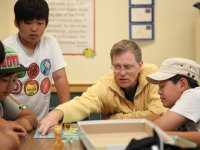English-Language Learners and Academic Language
Your content has been saved!
Go to My Saved Content.Editor's Note: This blog was co-authored by Katie Hull Sypnieski. Portions of this post are excerpted from their book, The ESL/ELL Teacher's Survival Guide: Ready-to-Use Strategies, Tools, and Activities for Teaching English-Language Learners of All Levels.
Helping English-language learners develop proficiency in academic language has always been a priority for K-12 educators, and its importance has only been heightened with the advent of the Common Core. To better understand academic language, let's examine the distinction between two terms introduced by Jim Cummins, basic interpersonal communicative skills (BICS) and cognitive academic language proficiency (CALP), that have impacted both policy and practices in second-language education:
- BICS (also called communicative competence): listening and speaking skills that students tend to acquire quickly in a new language (within the first couple of years) in order to communicate in social situations, such as asking someone for directions.
- CALP: academic language and cognitively demanding skills required for classroom success. CALP usually takes between five and seven years to develop -- longer for students with less native language proficiency. Lectures, class discussions, research projects and skills (summarizing, analyzing, extracting and interpreting meaning; evaluating evidence; composing; and editing) require CALP.
More recent research has extended CALP to include the following three dimensions of academic English:
- Linguistic: knowledge of word forms, functions, grammatical elements and discourse patterns used in academic settings
- Cognitive: higher-order thinking involved in academic settings
- Sociocultural-psychological: knowledge of social practices involved in academic settings
Now That We Know What Academic Language Is,
How Do We Help Students Learn It?
We have two main sources for identifying what words constitute academic language that we must explicitly teach. The first source includes words and usage that are required by units we teach. After identifying critical vocabulary in, say, a persuasive essay unit -- convince, reason, counter-argument, etc. -- we will pre-teach approximately 20 words, first by reviewing pronunciation, and then by having students . . .
- Act out the words in a skit.
- Identify a physical gesture for the word ("opinion" might mean pointing to one's head).
- Write definitions of terms using their own words -- in English or in their home language.
- Create a "word chart" that we will also replicate on the wall. During the unit, students will periodically note when those words are used, and add new ones that they believe are important enough to recognize and remember.
The other primary source is an academic vocabulary list divided by grade level, like the list created by the Berkeley, California Public Schools or the guide developed by the Tennessee Department of Education (with Robert Marzano's assistance) that categorizes academic words by content area. Of course, other lists are also available on the Web.
An activity that uses words from these lists is one of the most popular lessons we facilitate. For 20 minutes three times each week, we divide students into groups determined by levels of English proficiency. (We support mixed groups and are opposed to tracking by ability. In our multilevel class, we clarify that divisions are based on whether students studied English in their home country, not intelligence.)
Then with peer tutors, student teachers, bilingual aides or instructors alternating as they facilitate an activity with one group -- while other students are doing something else -- we discuss three or four new words aligned with the appropriate "grade level." (The actual grade for the list -- kindergarten, first grade, etc. -- does not appear on the copies we give students. Our learners don't need to be reminded how far away they are from English proficiency.)
After defining words with the same reinforcing activities that we use with word charts for units, we write down "question and answer frames" for each of the words:
We ask each student questions, and then they question each other, adapting the "frames" to their own interests. Then students review previously learned words with each other.
Reinforcement Through Context
There are a number of reasons why students enjoy doing this activity. One, they teach each other -- both in their practice and by using prior knowledge to complete the question and answer frames. Two, we bring a spirit of fun to the lessons. For example, we might begin by modeling, "Do you believe that Mr. Ferlazzo is the best teacher in the world?" to provoke laughter (and disagreement!). Students will subsequently develop their own questions that apply academic vocabulary to a similarly humorous topic. And third, students can easily quantify how much new knowledge they are learning each day, because knowing they are making meaningful progress is essential for self-confidence (also known as The Progress Principle).
Research suggests that we need to come in contact with a new word many times in various contexts in order to truly learn it. So in addition to the methods already discussed, we reinforce new vocabulary knowledge in other ways, such as regular classroom games, use of Vine and Instagram to create definitions of the words (we show an example below, and you can see more here), and having students use online academic vocabulary exercises (our favorites are Vocabulary Exercises For The Academic Word List, The Academic Word List at UoP and English Online).
What has worked best for you and your students in teaching and learning academic vocabulary?
